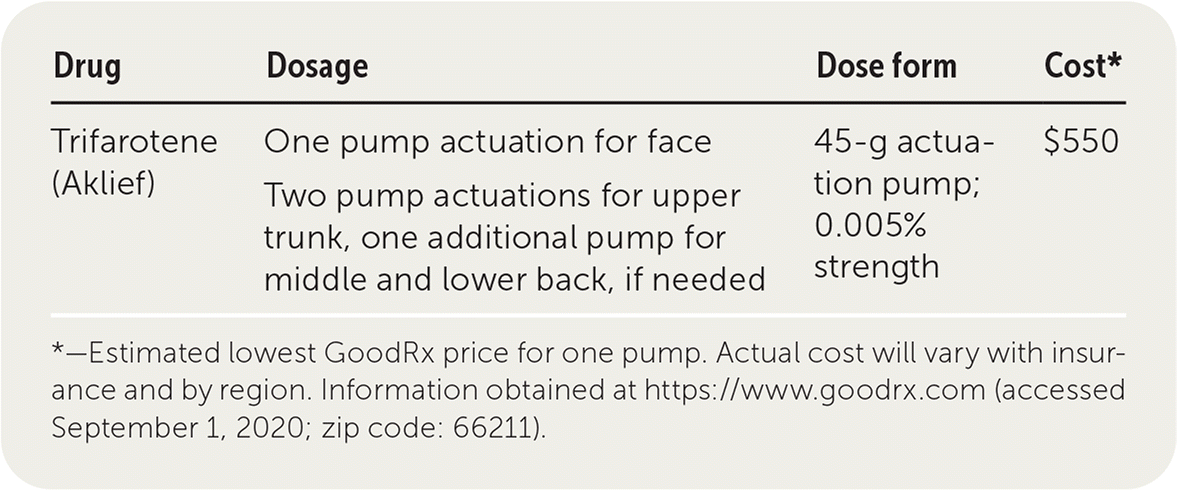
Am Fam Physician. 2020;102(8):503-504
Author disclosure: No relevant financial affiliations.
Trifarotene (Aklief) is a topical retinoid labeled for the treatment of facial and truncal acne vulgaris in patients nine years and older.1 Similar to other retinoids, its exact mechanism of action is not known, but it may work by normalizing keratinization and by having anti-inflammatory effects through stimulation of retinoic acid receptors.

| Drug | Dosage | Dose form | Cost* |
|---|---|---|---|
| Trifarotene (Aklief) | One pump actuation for face Two pump actuations for upper trunk, one additional pump for middle and lower back, if needed | 45-g actuation pump; 0.005% strength | $550 |
Safety
Trifarotene has not been shown to have serious adverse effects. When used during pregnancy, systemic retinoid therapy is teratogenic. Topical use of trifarotene has low systemic exposure, and limited data show there are no adverse fetal or maternal outcomes.1 There are no data on the presence of trifarotene in human breast milk or its effects on breastfed infants or milk production. Breastfeeding mothers should minimize potential exposure to the infant by using trifarotene on the smallest area of the skin away from the nipple and areola, and for the shortest duration possible.1
Tolerability
Trifarotene is generally well tolerated when used on the face and trunk. Erythema, scaling, dryness, and stinging will be reported by about one-third of users after one week of treatment, but it will not be severe in most cases.1 These effects peak within the first four weeks of treatment, after which symptoms begin to decline.1 While using trifarotene, patients should apply a moisturizer, minimize exposure to ultraviolet rays, and wear sunscreen and protective clothing over treated areas to lessen irritation.1
Effectiveness
Trifarotene has been studied in two 12-week, randomized, double-blind trials with a total of 2,420 patients who had both moderate facial and truncal acne characterized by both inflammatory and noninflammatory lesions. Treatment with 0.005% trifarotene was compared with vehicle alone.2 Most patients were White (81% to 93%), and they ranged in age from nine to 58 years (mean age = 19 years). Moderate acne was defined as a score of 3 on a five-point global assessment scale on the face or on the trunk as determined by the number of inflammatory lesions (average baseline count = 36 to 38) and noninflammatory lesions (average baseline count = 46 to 52).2 The primary end points were completely or almost clear skin at week 12 and the absolute change in lesion counts at both sites. In these two studies, 29.4% and 42.3% of patients who used trifarotene for facial acne achieved treatment success compared with 19.5% and 25.7% in the placebo group (numbers needed to treat = 10 and 6, respectively). Among patients treated with trifarotene for truncal acne, 35.7% and 42.6% achieved treatment success compared with 25.0% and 29.9% in the placebo group (numbers needed to treat = 9 and 8, respectively).2 Indirectly compared, the rates of complete clearing are similar to those with adapalene, benzoyl peroxide, or clindamycin.3,4
The long-term effectiveness of trifarotene also has been evaluated in a 52-week, open-label study of 453 patients nine years and older with moderate acne.5 Using the global assessment scoring system, success rates at week 12 were 26.6% for facial acne and 38.6% for truncal acne. Success rates increased to 65.1% and 66.9%, respectively, at week 52. This suggests long-term use of trifarotene may result in greater clearing of acne. Trifarotene has not been evaluated in combination with other treatments.
Price
One 45-g pump of trifarotene costs about $550. It is significantly more expensive than other topical prescription retinoids and over-the-counter treatments.
Simplicity
Trifarotene is applied once daily to the face, trunk, or both. It should be used with a moisturizer and sunscreen if the patient will be outside. A one-pump actuation is sufficient for the face and two to three actuations for the upper trunk. If skin irritation occurs, patients may reduce the frequency of the application or discontinue treatment.
Bottom Line
Trifarotene is a monotherapy option for acne affecting the face and trunk and offers an alternative to topical antibiotics or anti-inflammatory agents for the management of moderate inflammatory and noninflammatory acne. Trifarotene is expensive, especially compared with other prescription and nonprescription options, including other retinoids, and there is no evidence that it is any more effective.
